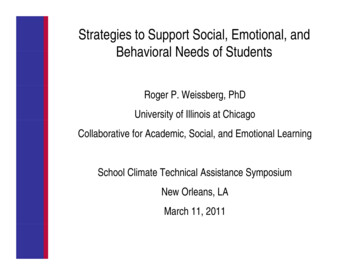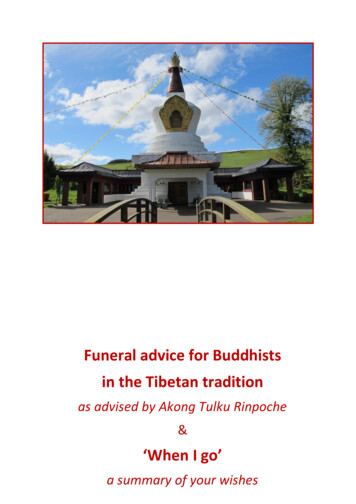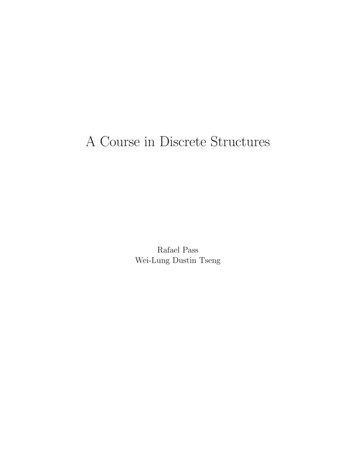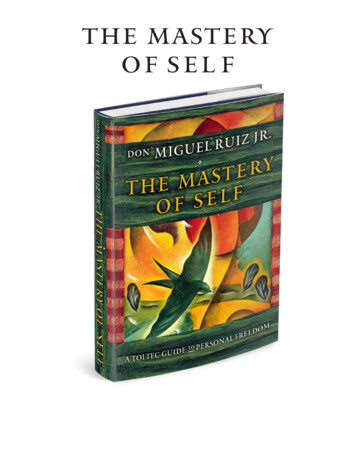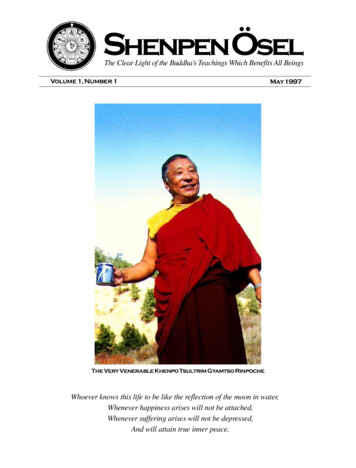
Transcription
ShenpenÖselThe Clear Light of the Buddha’s Teachings Which Benefits All BeingsVolume 1, Number 1May 1997The Very Venerable Khenpo Tsultrim Gyamtso RinpocheWhoever knows this life to be like the reflection of the moon in water,Whenever happiness arises will not be attached,Whenever suffering arises will not be depressed,And will attain true inner peace.
Contents(click on number)3 Tibetan Mountain YoginBrings Teachings on Emptiness to Seattle5 the reason wepracticemeditation,teaching by ThranguRinpoche13 The Six Aspects ofBardo,teaching by Tai SituRinpoche22 Just beingthere verysimply withyourself,teaching by LamaTashi Namgyal27 HimalayanWomen NeedYour Supportin Their Pursuitof the DharmastaffeditorLama Tashi NamgyalManaging editorLinda LewisPhotographerRyszard K. FrackiewicztranscribersGlen Avantaggio,Alan Castle, Rose Peeps,MarkVoss2SHENPEN ÖSELVolume 1, NumberShenpenÖselThe Clear Light of the Buddha’s Teachings Which Benefits All BeingsEDITORIAL POLICYDuring the soon-to-be four years of Kagyu Shenpen Ösel Chöling’s (KSOC)existence, we have sought to provide an opportunity for the people of theNorthwest — and in particular, for the people of the Seattle area — to meetthe clear light of the Buddha’s teachings so that they might derive the benefit thatdharma practitioners have derived from these teachings now for 2,500 years. Inparticular, we have sought to present the teachings transmitted by the many lineagesof what is loosely known as “Tibetan Buddhism,” with an emphasis on the teachingspassed down by the Karma Kagyu and Shangpa Kagyu lineages.To this end, KSOC has presented an ongoing program of teachings by LamaTashi Namgyal, a Western lama resident in Seattle, as well as occasional programs ofteachings by visiting Tibetan and Western lamas. During this time, in order topublicize these teachings, we have gradually found ourselves entering step by stepinto the publishing business, first by publishing brochures and later by publishingtwo newsletters.At the same time, we have been accumulating a growing library of tapes fromthese teachings, which in turn has spawned a small “cottage industry” of transcribers,who have been turning out transcripts of these teachings, which are gradually beingedited. If these teachings are more widely disseminated, they might bring greatbenefit to many sentient beings, both to those who initially attended these teachings,as well as to others who were unable to attend.Thus, KSOC is taking the bold step of printing an expanded newsletter ormagazine, in order to deliver in some depth the pure teachings of the dharma aspresented by recognized and fully qualified lamas and teachers, and to publicizeupcoming programs given by lamas of our lineage sponsored by dharma centersthroughout the Northwest. It is our intention to publish two, perhaps three times per year.Our general aspiration is reflected in the name we have chosen for our endeavor,“Shenpen Ösel.” Shenpen is Tibetan for “benefit to others;” Ösel literally means“clear light,” which in this context refers to the cognitive lucidity of the mind inwhich is inherent all positive virtues. It was based on the realization of the indivisibility of emptiness (Sanskrit: sunyata) and this cognitive lucidity, that the Buddhaspontaneously bestowed all of the teachings that have been passed down to us by allthe lineages of Buddhism to this day, and which have brought unimaginable benefitto countless sentient beings. This union of emptiness and cognitive lucidity is alsowhat is referred to as buddha nature, and is the true nature of mind of all sentientbeings. It is with the aspiration to present the clear light of the Buddha’s teachings,so that all beings may be inspired and assisted in uncovering their own true nature,that we embark on this endeavor for the benefit of others.May it bring benefit and may all be auspicious.
TibetanMountainYogin BringsTeachingsonEmptinesstoSeattleNorthwest dharma students will have a rare opportunity this June to hear teachingsfrom Tibetan mountain yogin and meditation master, The Very Venerable KhenpoTsultrim Gyamtso Rinpoche.In Seattle from June 17 through 25, Khenpo Rinpoche will give a series of teachings on therealization of sunyata or emptiness, entitled “On the True Nature of Mind.” These teachings willbe based on two commentaries of Nagarjuna: Mulamadhyamakakarika (The Fundamental Verseson the Middle Way Called Wisdom) and Dharmadhatustabam (The Praises to the Dharmadhatu).Direct experiential understanding or realization of sunyata is the ultimate goal of all Buddhistmeditation disciplines, including both Zen practice and the practice of Tibetan tantric Buddhism,because it is this realization that liberates one from all varieties of anxiety and suffering.Joining profound and vast knowledge of the dharma with profound realization of its truemeaning, Khenpo Rinpoche communicates brilliantly, directly, and indelibly the essence of thepath of the Buddha. He is famous for his skill in debate; and his book, Progressive Stages ofMeditation on Emptiness, is regarded as a classic presentation of the stages of development of apractitioner’s progressive understanding of sunyata.Khenpo Rinpoche was born in Eastern Tibet in l934. During and after receiving extensiveteachings and empowerments from Lama Zopa Tharchin, His Holiness Dilgo KhyentseRinpoche, Dilyak Druppön Rinpoche, and His Holiness the 16th Gyalwa Karmapa, he spentmany years living and meditating in caves and roaming and meditating in charnel grounds andcemeteries in Eastern and Central Tibet.In 1959, he led a group of nuns who were having difficulty dealing with the Chinese invasion of Tibet to India. In the ensuing nine years, Khenpo Rinpoche lived in the Tibetan refugeecamp in Buxador where he gained his khenpo degree from His Holiness the Gyalwa Karmapa.SHENPEN ÖSEL 3
He later received the geshe lharampa degree from HisHoliness the Dalai Lama. During this time, he also receivedthe vast cycle of Padmasambava’s terma called the RinchenTerdzö from His Holiness Dilgo Khyentse Rinpoche, andextensive teachings from the former Dzongsar KhyentseRinpoche. During this time he completed and mastered thestudies of the sutras and tantras of all four schools ofTibetan Buddhism (Gelug, Sakya, Kagyu, and Nyingma).In 1976, with the blessings of His Holiness Karmapa,Khenpo Rinpoche established Thegchen Shedra in France,where he trains translators in depth in the study of Tibetantexts. In 1985, he established Marpa Institute for Translators in Nepal, where he has also guided many students inretreat near Milarepa’s cave in Yolmo.Together with Thrangu Rinpoche, he has been responsible for training the next generation of Kagyu khenposwho graduated in 1991 from the Nalanda Institute, foundedby His Holiness Karmapa in mily is impermanent, like a rainbowin the sky. To give up clinging to it aspermanent and true is in accordance withthe dharma. To abide in the true nature ofmind, in clear light free from mentalfabrications, relaxedly and self-subsidingly,is the supreme of all meditations.”“The fortunate student knows how to see this lifeas a dream. If you look again and again into theunborn nature of mind and know how to restrelaxed, then within mind’s own nature itself youwill realize mahamudra.”4 SHENPEN ÖSELRinpoche’sScheduleofJuneTeachingsKhenpo Rinpoche will present an understanding of sunyata and buddha nature both fromthe point of view of the second cycle of the teachings of the Buddha and of the third and last cycleof the teachings of the Buddha. Those who canattend all 11 sessions will benefit greatly. Theschedule is as follows:Teachings based onNagarjuna s MulamadhyamakakarikaTuesday-Thursday, June 17-19Monday-Wednesday, June 23-257:30-9:30 p.m.Kagyu Shenpen Ösel Chöling (KSOC)4322 Burke Ave. N. (Wallingford neighborhood)Teachings based onNagarjuna s DharmadhatustabamFriday, June 207:30-9:30 p.m.Saturday and Sunday, June 21 and 2210 a.m.-12:30 p.m. and 2:30-5 p.m.Catherine Blaine Elementary School, Room 1442550 34th Ave. W. (Magnolia neighborhood)Those who wish to meditate before each sessionshould plan on arriving half an hour before theteachings begin.Cost is 150 for the entire series and 75 for theFriday, Saturday, Sunday teachings only.Attendance is limited to 60 at KSOC and to 100 atCatherine Blaine; pre-registration is encouraged.For further information, call: (206) 632-1439,(206) 722-6970, or (206) 323-4421.For Rinpoche s fall schedule in the U.S., see page 29.
The Reason We Practice MeditationBy V.V. Thrangu RinpocheIn the spread of Buddhism in America, the Kagyulineage was in the forefront of the sending of lamas toAmerica. Of these lamas, the three great progenitors ofthe dharma in America were His Holiness the GyalwaKarmapa, His Eminence Kalu Rinpoche, and theVidyadhara Chögyam Trungpa Rinpoche.It was very unfortunate that in the 1980s we lost allof these great beings, but in the aftermath, there were anumber of remarkable lamas in the lineage who steppedforward to fill their places and to bring great benefit tosentient beings. Amongst these, in the forefront of them,was The Very Venerable Khenchen Thrangu Rinpoche,abbot by appointment of His Holiness Karmapa ofRumtek Monastery in Sikkim. He is also abbot of hisown monasteries in Nepal and Tibet, of Tara Abbey — awomen’s monastery in Nepal, and by appointment ofChögyam Trungpa Rinpoche, of Gampo Abbey in NovaScotia.In addition he has been very generous and kind toWestern students, teaching the dharma extensively inretreats and seminars throughout the world.Rinpoche taught in Seattle for the first time in May1996. This transcript is from his teachings the eveningof May 24.(Chants.)The essence of the buddha-dharma, the teachings ofthe Buddha, is practice. And when we say practice, wemean the practice of meditation, which can consist ofeither the meditation known as tranquility or that knownas insight. But in either case, it must be implemented inactual practice. The reason we practice meditation is toattain happiness. And this means states of happiness inboth the short term and the long term. With regard toshort-term happiness, when we speak of happiness, weusually mean either or both of two things, one of whichis physical pleasure and the other of which is mentalpleasure. But if you look at either of these pleasantexperiences, the root of either one has to be a mind thatis at peace, a mind that is free of suffering. Because aslong as your mind is unhappy and without any kind oftranquility or peace, then no matter how much physicalpleasure you experience, it will not take the form ofhappiness per se. On the other hand, even if you lackthe utmost ideal physical circumstances of wealth andso on, if your mind is at peace, you will be happyanyway.We practice meditation, therefore, in part in order toobtain the short-term benefit of a state of mental happiness and peace. Now, the reason why meditation helps’d like to begin by welcomingall of you here tonight. Irecognize that you’ve come hereout of your sincere interest in, andwish to practice, genuine dharma,and out of your respect for myteaching. And this is all delightfulto me, and I thank you for it. Iconsider myself fortunate to havesuch an opportunity to form such aconnection with you. To begin, Iwould like to recite a traditionalsupplication to the teachers of mylineage, and while doing so, Iinvite you to join me in an attitudeof confidence and devotion.IThe Very Venerable Thrangu RinpocheSHENPEN ÖSEL 5
with this is that, normally, we have a great deal ofthought, or many different kinds of thoughts runningthrough our minds. And some of these thoughts arepleasant, even delightful. Some of them, however, areunpleasant, agitating, and worrisome. Now, if youexamine the thoughts that are present in your mindfrom time to time, you will see that the pleasantthoughts are comparatively few, and the unpleasantthoughts are many — which means that as long as yourmind is ruled or controlled by the thoughts that passthrough it, you will be quite unhappy. In order to gaincontrol over this process, therefore, we begin with themeditation practice of tranquility,which produces a basic state of contentment and peace within the mind ofthe practitioner.AWe begin withthe meditationpractice oftranquility,which producesa basic state ofcontentmentand peacen example of this is the greatTibetan yogi Jetsun Milarepa,who lived in conditions of the utmostausterity. He lived in utter solitude, incaves and isolated mountains. Hisclothes were very poor; he had nonice clothes. His food was neitherrich nor tasty. In fact, [for a numberof years] he lived on nettle soupalone, as a result of which he becamephysically very thin, almost emaciated. Now, if youconsider his external circumstances alone, the isolationand poverty in which he lived, you would think he musthave been miserable. And yet, as we can tell from themany songs he composed, because his mind wasfundamentally at peace, his experience was one ofconstant unfolding delight. His songs are songs thatexpress the utmost state of delight or rapture. He sawevery place he went to, no matter how isolated andaustere an environment it was, as beautiful, and heexperienced his life of utmost austerity as extremelypleasant.In fact, the short-term benefits of meditation aremore than merely peace of mind, because our physicalhealth as well depends, to a great extent, upon our stateof mind. And therefore, if you cultivate this state ofmental contentment and peace, then you will tend not tobecome ill, and you will as well tend to heal easily ifand when you do become ill. The reason for this is thatone of the primary conditions which brings about states6 SHENPEN ÖSELof illness is mental agitation, which produces a corresponding agitation or disturbance of the channels andenergies within your body. These generate new sicknesses, ones you have not yet experienced, and alsoprevent the healing of old sicknesses. This agitation ofthe channels and winds or energies also obstructs thebenefit which could be derived from medical treatment.If you practice meditation, then as your mind settlesdown, the channels and the energies moving throughthe channels return to their rightful functioning, as aresult of which you tend not to become ill and you areable to heal any illnesses you already have. And we cansee an illustration of this also in thelife of Jetsun Milarepa, who engagedin the utmost austerities with regard towhere he lived, the clothes he wore,the food he ate, and so on, throughoutthe early part of his life. And yet thisdid not harm his health, because hemanaged to have a very long life, wasextremely vigorous and youthful tothe end of his life, which indicates thefact that through the proper practice ofmeditation, the mental peace and contentment that is generated calms down orcorrects the functioning of the channelsand energies, allowing for the healing ofsickness and the prevention of sickness.The ultimate or long-term benefit of the practice ofmeditation is becoming free of all suffering, whichmeans no longer having to experience the sufferings ofbirth, aging, sickness, and death. Now, this attainmentof freedom is called, in the common language of allBuddhist traditions, buddhahood, and in the particularterminology of the vajrayana, the supreme attainment,or supreme siddhi. In any case, the root or basic causeof this attainment is the practice of meditation. Thereason for this is, again, that generally we have a lot ofthoughts running through our minds, some of which arebeneficial — thoughts of love, compassion, rejoicing inthe happiness of others, and so on — and many ofwhich are negative — thoughts of attachment, aversion,jealousy, competitiveness, and so on. Now, there arecomparatively few of the former type of thought andcomparatively many of the latter type of thought,because we have such strong habits that have beenaccumulating within us over a period of time without
beginning. And it’s only by removing these habits ofnegativity that we can free ourselves from suffering.You cannot simply remove these mental afflictions,or kleshas, by saying to yourself, “I will not generateany more mental affliction,” because you do not havethe necessary freedom of mind or control over thekleshas to do so. In order to relinquish these, you needto actually attain this freedom, which begins, accordingto the common path, with the cultivation of tranquility.Now, when you begin to meditate, [when] you begin topractice the basic meditation of tranquility meditation,you may find that your mind won’t stay still for amoment. But this is not permanent.This will change as you practice, andyou will eventually be able to placeyour mind at rest at will, at whichpoint you have successfully alleviatedthe manifest disturbance of thesemental afflictions or kleshas. On thebasis of that, then you can apply thesecond technique, which is calledinsight, which consists of learning torecognize and directly experience thenature of your own mind. This natureis referred to as emptiness. When yourecognize this nature and rest in it,then all of the kleshas, all of the mental afflictions thatarise, dissolve into this emptiness and are no longerafflictions. Therefore, the freedom, or result, which iscalled buddhahood, depends upon the eradication ofthese mental afflictions, and that depends upon thepractice of meditation.make up our experience of samsara. And in order totranscend this process, we need to transcend theseimpure projections, together with the suffering that theybring about. A very effective way to do this is to replacethese gradually, replace these projections of impurity,with pure projections, based on the iconography of theyidam, the dharmapala, and so on. By starting toexperience the world as the mandala of the deity and allbeings as the presence of that deity, then you graduallytrain yourself to let go of mental afflictions, let go ofimpure projections, and you create the environment forthe natural manifestation of your own innate wisdom.Now, all of this occurs graduallythrough this practice of the generationstage. The actual deities who are usedcan vary in appearance. Some of themare peaceful and some of them arewrathful. In general, the iconographyof the wrathful deities points out theinnate power of wisdom, and that of thepeaceful deities the qualities of lovingkindness and compassion. Also, thereare male deities and female deities. Themale deities embody the method orcompassion, and the female deitiesembody intelligence or wisdom.For these reasons, it’s appropriate to perform thesepractices of meditation upon deities. And because thesepractices are so prevalent in our tradition, if you go intoa vajrayana practice place or temple, you will probablysee lots of images of deities — peaceful deities, wrathful deities, and extraordinarily wrathful deities. Andyou’ll see lots of shrines with some very eccentricofferings on them. Initially, if you’re not used to all this,you might think, “What is all this?” And you might feel,“Well, the basic practices of tranquility and insightmake a lot of sense, and are very interesting; and allthese deities, all these rituals, and all these eccentricmusical instruments are really not very interesting atall.” However, each and every aspect of the iconography, and each and every implement you find in a shrineroom, is there for a very specific reason. The reason ingeneral is that we need to train ourselves to replace ourprojection of impurity or negativity with a projection orexperience of purity. And you can’t simply fake this,you can’t simply talk yourself into this, because you’retrying to replace something that is deeper than a con-The ultimateor long-termbenefit of thepractice ofmeditation isbecoming freeof all sufferinghe practice of tranquility and insight is the generalpath which is common to both the paths of sutra andtantra. In the specific context which is particular to thevajrayana, the main techniques are called the generationstage and the completion stage. These two techniquesare extremely powerful and effective. Generation stagerefers to the visualization of, for example, the form of alineage guru, the form of a deity or yidam, or the formof a dharma protector. Now, initially, when first encountering this technique, it’s not uncommon for beginnersto think, what is the point of this? Well, the point of thisis that we support and confirm our ignorance andsuffering and our kleshas through the constant generation of impure projections or impure appearances whichTSHENPEN ÖSEL 7
cept. It’s more like a feeling. So, therefore, in thetechnique by which you replace it, a great deal offeeling or experience of the energy of purity has to beactually generated, and in order to generate that, we usephysical representations of offerings, we use musicalinstruments in order to inspire the feeling of purity, andso on. In short, all of these implements are useful inactually generating the experience of purity.That is the first of the two techniques of vajrayanapractice, the generation stage. The second technique is called the completion stage, and it consists of avariety of related techniques, of which perhaps the mostimportant and the best known aremahamudra and dzogchen or “thegreat perfection.” Now, sometimes, itseems to be presented that dzogchen ismore important, and at other times itseems to be presented that mahamudrais more important, and as a resultpeople become a little bit confusedabout this and are unsure whichtradition or which practice they shouldpursue. Ultimately, the practices inessence and in their result are thesame. In fact, each of them has a variety of techniqueswithin it. For example, within mahamudra practicealone, there are many methods which can be used, suchas a candali* and so forth, and within the practice ofdzogchen alone there are as well many methods, suchas the cultivation of primordial purity, spontaneouspresence, and so on. But, ultimately, mahamudrapractice is always presented as guidance on, or anintroduction to, your mind, and dzogchen practice isalways presented as a guidance on or introduction toyour mind. Which means that the root of these is nodifferent, and the practice of either mahamudra ordzogchen will generate a great benefit. Further, we findin The Aspiration of Mahamudra by the third GyalwaKarmapa, Lord Rangjung Dorje, the following stanza:It is not non-existent, it is the basis of all Samsara and Nirvana.This is not contradictory, but is the great Middle Way.May I come to see the nature which is beyond elaboration.And that is from the mahamudra tradition. Then, inThe Aspiration for the Realization of the Nature of theGreat Perfection by the omniscient Jigme Lingpa, anaspiration liturgy from the dzogchen tradition, we find thefollowing stanza:It does not exist, it has not been seen, even by the Victors.It is not non-existent, it is the basis of all Samsara and Nirvana.It is not contradictory, it is the great Middle Way.May I come to recognize dzogpa chenpo, thenature of the ground.Meditation,however, dependsin part upon thegeneration ofloving-kindnessand compassionIt does not exist, and has not been seen, even by the Victors.*gtum-mo in Tibetan, meaning fierce or wrathful and referring to akind of psychic heat generated and experienced through certainmeditative practices of the vajrayana. This heat serves to burn up alltypes of obstacles and confusion. Included in the Six Doctrines ofNaropa, the Six Doctrines of Niguma, and the Six Doctrines of Sukhasiddhi.8 SHENPEN ÖSELIn other words, these two traditions are concerned entirely with therecognition of the same nature.So both short-term and ultimatehappiness depend on the cultivationof meditation, which from the common point of view of the sutras [thepoint of view held in common by alltraditions of Buddhism] is tranquilityand insight, and from the uncommon point of view ofthe vajrayana is the generation and completion stages.Meditation, however, depends in part upon thegeneration of loving-kindness and compassion. Andthis is true of any meditation, but it is especially mosttrue of vajrayana meditation. The reason is that thespecific vajrayana practices — the visualization ofdeities or meditation upon mahamudra and so on —depend upon the presence of a pure motivation on thepart of the practitioner from the very start. If this puremotivation or genuine motivation is not present — and,since we’re ordinary people, it’s quite possible that itmight not be present — not much benefit will reallyoccur. For that reason, vajrayana practitioners alwaystry to train their motivation, and try to develop themotivation that’s known as the awakened mind, orbodhichitta.Now, as an indication of this, if you look at theliturgies used in vajrayana practice, you’ll see that thelong and extensive forms of vajrayana liturgies alwaysbegin with a clarification of, or meditation upon,bodhichitta, and that even the short and shortest liturgies
always begin with a meditation upon bodhichitta, lovingkindness and compassion, the point of this being that this typeof motivation is necessary for all meditation, but especially forvajrayana practice.The only real meaning that we can give to our being bornon this planet — and in particular being born as humanbeings on this planet — and the only really meaningful resultthat we can show for our lives is to have helped the world: tohave helped our friends, to have helped all the beings on thisplanet as much as we can. And if we devote our lives or anysignificant part of our lives to destroying others and harmingothers, then to the extent that we actually do so, our liveshave been meaningless. So if you understand that the onlyreal point of a human life is to help others,to benefit others, to improve the world,then you must understand that the basis ofnot harming others but benefiting others ishaving the intention not to harm othersand the intention to benefit others.Now, the main cause of having such astable intention or stable motivation is theactual cultivation of love and compassionfor others. Which means, when you findyourself full of spite and viciousness —and it is not abnormal to be so — then youhave to recognize it, and be aware of it aswhat it is, and let go of it. And then, eventhough you may be free of spite orviciousness, and you may have the wish toimprove things, you may be thinking onlyof yourself; you may be thinking only ofhelping or benefiting yourself. When that’sthe case, then you have to recollect that theroot of that type of mentality, which isquite petty and limited and tight, isdesiring victory for yourself even at theexpense of the suffering and loss experienced by others. And, in that case, you have to graduallyexpand your sympathy for others, and therefore this cultivation of bodhichitta or altruism in general as a motivation is anessential way of making your life meaningful.The importance of love and compassion is not an ideathat is particular to Buddhism. Everyone throughout theworld talks about the importance of love and compassion.There’s no one who says love and compassion are bad and weshould try and get rid of them. However, there is an uncommon element in the method or approach which is taken tothese by Buddhism. In general, when we think of compassion, we think of a natural or spontaneous sympathy orempathy which we experience when we perceive the sufferingof someone else. And we generally think of compassion asbeing a state of pain, of sadness, because you see the suffering of someone else and you see what’s causing that sufferingand you know you can’t do anything to remove the cause ofthat suffering and therefore the suffering itself. So, whereasbefore you generated compassion, one person was miserable,after you generate compassion, two people are miserable. Andthis actually happens.However, the approach [that the Buddhist tradition takes]to compassion is a little bit different, because it’s founded onthe recognition that, whether or not youcan benefit that being or that person intheir immediate situation and circumstances, you can generate the basis for theirultimate benefit. And the confidence in thatremoves the frustration or the miserywhich otherwise somehow afflicts ordinarycompassion. So, when compassion iscultivated in that way, it is experienced asdelightful rather than miserable.The way that we cultivate compassionis called immeasurable compassion. And, infact, to be precise, there are four aspects ofwhat we would, in general, call compassion, that are called, therefore, the fourimmeasurables. Now, normally, when wethink of something that’s called immeasurable, we mean immeasurably vast. Here,the primary connotation of the term is notvastness but impartiality. And the point ofsaying immeasurable compassion is compassion that is not going to help one personat the expense of hurting another. It is acompassion that is felt equally for allbeings. The basis of the generation of such an impartialcompassion is the recognition of the fact that all beingswithout exception really want and don’t want the samethings. All beings, without exception, want to be happy andwant to avoid suffering. There is no being anywhere whoreally wants to suffer. And if you understand that, and to theextent that you understand that, you will have the intensewish that all beings be free from suffering. And there is nobeing anywhere who does not want to be happy; and if youunderstand that, and to the extent that you understand that,The only reallymeaningfulresult that wecan show for ourlives is to havehelped the worldSHENPEN ÖSEL 9
you will have the intense wish that all beings actually achievethe happiness that they wish to achieve. Now, because theexperience of happiness and freedom from suffering dependupon the generation of the causes of these, then the actualform your aspiration takes is that all beings possess not onlyhappiness but the c
the clear light of the Buddha’s teachings so that they might derive the benefit that dharma practitioners have derived from these teachings now for 2,500 years. In particular, we have sought to present the teachings transmitted by the many lineages of what is loosely known as “Tibe

